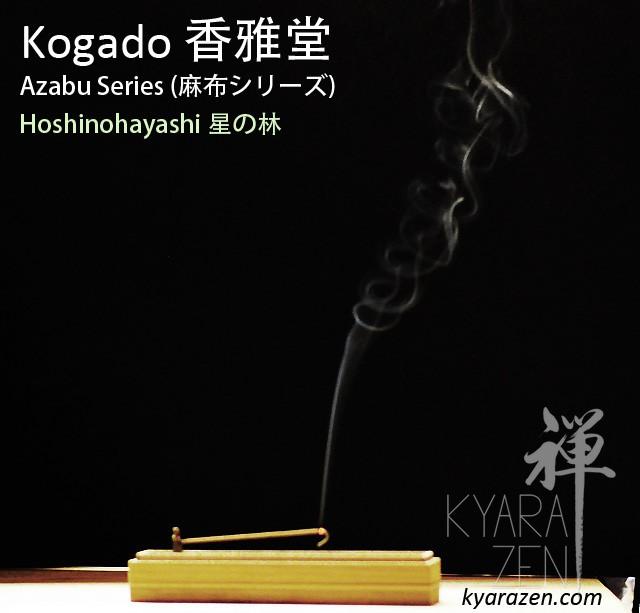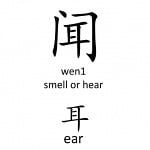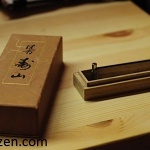I’ve tried hundreds of Japanese Incenses to date, and I have to admit that there are times when I burn a stick made by a big incense company, I remain unexcited and unflattered about it. Some of these incenses do not feel alive to me, they lack clarity, there is no sense of human touch. To a certain extent, some of these mass production incenses that large factories churn out seem a little confused with no direction, cold and without spirit.
So for the past year or so, I refocused my energies in sourcing incenses from smaller companies such as Kida Jinseido, Yamadamatsu, Kyukyodo, Koyasan Daisido etc. Kogado (香雅堂) is one of the companies on my list, and I’m very glad to have been able to arrange the purchase of a sampler set of all the incenses that Kogado makes. Mariko-san of Kogado was extremely accommodating to such a request, I posted over acrylic tubes to facilitate the safe shipping of the incense sticks, and payment was made through remittance through a friend residing in Japan. (This is the difference between a smaller company versus a big one! I don’t think a big company would entertain such a request!! – please prove me wrong!!!).

The assortment of 24 different incense types together with their hand written labels arrived safely a few days after payment was sent. Kogado produces several lines of products.
The first line of incenses is a set of Tale of Genji-inspired incenses. Drawing from the scenes and the various seasons etc, these incenses were crafted to present the aristocratic scent of the Hei-an period in Japan.
The second line of products is their Azabu series, which is a premium fragrant wood series generally made of top quality ingredients together with binder powder. Without mixing in a large myriad of herbs, the fragrant wood materials in this series is allowed to sing for itself. I will be reviewing their Hoshinohayashi at the end of this article.
The third line is the Senshibanko series, which is a floral/flower based theme. No synthetics, only pure essential oils were used in the creation of these incenses, namely Lotus, Lavender, Jasmine, Citrus and Rose.
The fourth line of incenses is their Suiko series, a series of incenses revolving around an ancient theme, the scent or incenses of the ancient times with seasonal influence.
The fifth line of products is the most modern series, offering incenses blended with essential oils to suit the taste of modern times.

It wasn’t too hard to decide on which stick I wanted to burn first. Used to the high-end incense offerings on the Japanese market, there were no qualms in picking out the current “highest” end stick from Kogado in this sampler set, the Azabu Hoshinohayashi to be the first Kogado incense subjected to assessment. There are 3 other incenses in the Azabu series that are not released to the market yet, thus allowing Hoshinohayashi to take the crown for the moment.

Incense : Hoshinohayashi
Brand : Kogado
Source : Purchased from Japan
Price : 472 yen / 5 sticks, 2625 yen for a box of 20 grams (60 sticks)
Amount Burnt so far prior to this review : 1 stick
Taste profile : Sweet : ++++ Other tastes : None
Scent characteristics : Texture – Thin velvety layer of cream Binder notes – none detectable Intensity – ++
Focus : Expansive
Listen : A quiet slow, romantic violin solo, a gentle lullaby
Difficulty Level : Low
Incense perception distance : 45 cm away

Impressions : This is by far the ultimate pure mysore sandalwood stick I’ve ever came across in Japanese Incenses! Having had several hours of heavy rain where I am, perhaps this picture outside my window is the most apt in describing the exact olfactory experience during the burn process of this incense, tranquil, cool, sweet, misty with bright sparkles. At the back of my head, the Phantom of the Opera’s Music of the Night plays at half its usual speed.

Although the highest expectations amongst some incense lovers is a sandalwood stick with the thickest creamy notes, I beg to differ a little with this, too much cream almost induces a complete olfactory fatigue after a while. My highest expectation of a sandalwood stick is one that can produce the whole spectrum of “sandalwoodyness” at the right burning temperature, to allow for the listener to embrace the complete sandalwood experience consisting the lush, mildly floral woodiness of younger parts of the tree interwoven with the creamy notes of the aged old heart wood, and a light cooling touch that trails quietly in the background almost like the scent of watermelon skin, characteristic of the original mysore raw material. Kogado’s Hoshinohayashi fulfills this expectation with good balance.
Whilst other incense makers may consider blending sandalwood further, or to use other herbs just to bring costs down, this stick here is luxuriously made of 82% pure mysore sandalwood powder, with 3% camphor to accentuate and bring out the cooling notes, and 15% binder powder, just enough to prevent the stick from being too crumbly and fall apart. At the price point of 2625 yen for a box of 20 gram, this price is incredibly reasonable to me as mysore sandalwood is now close to USD $1 per gram from several reliable sources.
Another aspect of this incense, is the beauty to which it burns. A coarser grind, low binder content would probably mean that this incense stick is probably hydraulically extruded slowly to have it remain intact. A result of the coarser grind, little granules of sandalwood can be seen on the stick, ready to burst forth with fragrance when heat approaches, releasing gust after gust of pure sweet mysore smoke.


Most of all, this incense not only provides one with olfactory pleasure, but also visual enjoyment on how delicious wisps of fragrance dances through the air, slowing down into a waltz before disappearing into nothingness.
A great performance.
The stick burns out
The concert ends.
All that lingers,
A sandalwood mist
Hovering in a deep darkness.
The Audience sighs in satisfaction.

Perhaps at this point of time, my dear readers, have you ever burnt a Japanese incense stick and tried to single out the aloeswood / sandalwood notes to find that it is heavily fused or intertwined with other herbs and ingredients, making it difficult to perceive? Well, this had happened to me very many times, even after having developed better olfactory acuity, there are some blends that I find obtrusive.
I applaud Kogado for having created this fine incense, it is a very niche incense stick as very few makers focus on presenting top quality sandalwood to this level of clarity and purity. And now that the yardstick is set, I have great expectations into moving into the other sticks, probably with the Suiko series first, followed by the Genji series.
I hope that in due time, Kogado will be willing to take their business online and to the international community, so that more people can get to enjoy their incenses. I’m particularly excited about the next three incenses (agarwood based) in the Azabu line, given that they could present sandalwood at this level, it leaves me strong anticipation to see if they could present agarwood the same delightful way.
Their website at www.kogado.co.jp is extremely educational, covering aspects on japanese Kodo very much more in depth than any known english resource on this topic, providing informations on incense ingredients, processes, methods, ideologies, and a up to date blog which is very educational to read if you know some Japanese.
Kogado’s Hoshinohayashi, Kyarazen recommended!!




